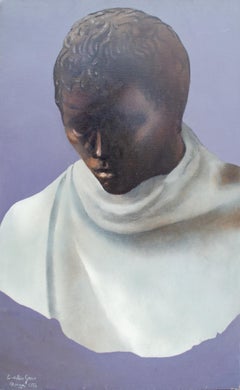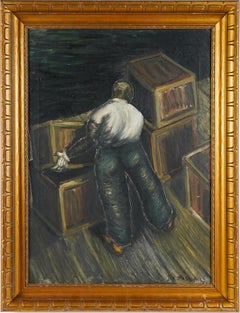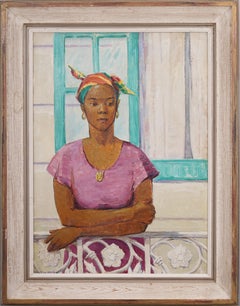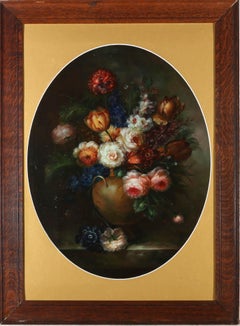Emilio Greco Paintings
Italian, 1913-1995
Emilio Greco, (born Oct. 11, 1913, Catania, Italy—died April 5, 1995, Rome), Italian sculptor of bronze and marble figurative works, primarily female nudes and portraits.
At the age of 13, Greco was apprenticed to a stonemason, and he later studied at the Academy of Art in Palermo. Though he began exhibiting in Rome in 1943, he was not well-established until after World War II. His first solo exhibition was held in 1946, and in 1948 he became a teaching assistant at the Artistic Secondary School in Rome.
His subject matter varied little throughout his career. In their refined, elongated forms and assertive balance, his sculpted figures reflect the Mannerist tradition in Italian art (e.g., Bather No. 2, 1956–57). The expressive, luminous surface treatment in some pieces, however, strikes a clear parallel with the work of Giacomo Manzù and Marino Marini.
He designed one of the bronze doors of the Cathedral at Orvieto (1961–64) and the monument to Pope John XXIII in Saint Peter’s (1965–67). In 1974 a Greco Garden, dedicated to his works, was opened at the Open Air Museum, Hakone, Japan. In 1991 a group of Greco’s works, donated by the artist to the city of Orvieto, was placed on permanent exposition at the Palazzo Soliano.
Source: "Emilio Greco," Encyclopedia Britannica, 2017to
1
Overall Width
to
Overall Height
to
1
1
1
1
1
1
1
1
1
1
1
1
34
784
723
706
695
1
Artist: Emilio Greco
Original Emilio Greco Painting, titled "Roma", 1972
By Emilio Greco
Located in New York, NY
Emilio Greco (Italian, 1913-1995)
Roma, 1972
Oil on canvas
45 1/2 x 28 3/4 in.
Signed and inscribed lower left: Emilio Greco, Roma, 1972
Emilio Greco, (born Oct. 11, 1913, Catania, Italy—died April 5, 1995, Rome), Italian sculptor of bronze and marble figurative works, primarily female nudes and portraits.
At the age of 13, Greco was apprenticed to a stonemason, and he later studied at the Academy of Art in Palermo. Though he began exhibiting in Rome in 1943, he was not well-established until after World War II. His first solo exhibition was held in 1946, and in 1948 he became a teaching assistant at the Artistic Secondary School in Rome.
His subject matter varied little throughout his career. In their refined, elongated forms and assertive balance, his sculpted figures...
Category
1970s Modern Emilio Greco Paintings
Materials
Canvas, Oil
Related Items
Antique American School WPA Modernist Black Figure Ashcan Dock View Oil Painting
Located in Buffalo, NY
Oil on canvas. Framed. Signed.
Category
1920s Modern Emilio Greco Paintings
Materials
Canvas, Oil
$780 Sale Price
20% Off
H 36 in W 27 in D 2 in
Large Antique American Bahamian Young Woman Portrait Signed Rare Oil Painting
Located in Buffalo, NY
Really rare and well painted portrait by Christine Walters Martin (1895-1982). Oil on canvas. Framed in a nice modernist molding. Signed.
Artist Bio:
Christine Walters Martin (1895-1982)
Born and raised in Brooklyn, Christine Martin majored in art at Columbia University/Teachers College. She spent summers painting at the Woodstock Art Colony under the tutelage of artists there and continued her art studies at the Art Student's League in New York City. Over the years, her teachers included John Sloan, Yasuo Kuniyoshi, Alexander Brook and John McFee. She also studied with Eugene Speicher, who recommended her for Portraits Inc, through which some of his own commissions came. Much later in life, in her 80s, Christine studied watercolor with Zoltan Szabo.
Before marrying attorney George Martin in 1923, she taught art in the New York public schools for several years. During summers in the late 1920s, after having two daughters (Cynthia, 1924-2008, and Joan, 1927-2000), she went to Woodstock with her girls in tow, staying at the Hasbrook farm. In 1930, she and her husband purchased a stone house on Ohayo Mountain Road and lived there seasonally for 25 years. Among her closest artist friends in Woodstock were Emil Ganso, Florence Hardiman, Albert Heckman, Peggy Dodds, Joe Rollo, Henry Mattson, Mary Ellen Early, and Maud and Miska Petersham, along with Juliana Force (Whitney Museum). During many summers in Woodstock, Christine's daughters Cynthia and Joan kept up their serious piano studies under the tutelage of Vladimir Padwa and Inez Carroll.
Known for portraits and landscapes, she was a member of the National Association of Women Artists and the National Arts Club, Gramercy Park, NY. Her work showed at the National Arts Club, Weyhe and Preston Galleries and the National Academy of Design in New York; the Pennsylvania Academy in Philadelphia; the Woodstock Art Association and Rudolf Galleries in Woodstock, Vermont's Dawson Grist Mill Gallery, and South Hampton College, among others. Her portraits, landscapes and still lives hang in hundreds of homes around the world.
Information provided by Bunny McBride...
Category
1920s Modern Emilio Greco Paintings
Materials
Canvas, Oil
$2,495 Sale Price
48% Off
H 45 in W 35 in D 3 in
Antique American Modernist WPA Female Portrait Interior Exhibited Oil Painting
By Anatol Shulkin
Located in Buffalo, NY
Antique American modernist interior portrait oil painting. Oil on board, circa 1930. Unsigned. Displayed in a period modernist frame. Exhibition provenance verso. Image size, 25"L ...
Category
Early 20th Century Modern Emilio Greco Paintings
Materials
Canvas, Oil
$3,880 Sale Price
20% Off
H 28 in W 33 in D 2 in
Early 20th century Art Deco Male nude oil painting of Narcissus
By George Frederick Hinchcliff
Located in Harkstead, GB
An incredibly striking study of the male form with the figure set against a colourful background with stylised organic forms. Attractively framed, the painting is ready to be hung an...
Category
1930s Modern Emilio Greco Paintings
Materials
Oil, Canvas
$1,578 Sale Price
29% Off
H 16 in W 20 in D 2 in
Rare Early Antique American School Fauvist Woman Portrait Framed Oil Painting
Located in Buffalo, NY
Antique American modernist portrait oil painting. Oil on canvas, lain to board. Framed. Very finely painted and a rare fauvist palette. No signature found.
Category
1920s Modern Emilio Greco Paintings
Materials
Canvas, Oil
$7,800 Sale Price
20% Off
H 23 in W 20 in D 2 in
Antique American School Signed Framed Modernist "Massage" Oil Painting
Located in Buffalo, NY
Vintage American signed interior scene oil painting. Oil on canvasboard. Signed. Framed. Image size, 14L x 11H.
Category
1950s Modern Emilio Greco Paintings
Materials
Canvas, Oil
$236 Sale Price
20% Off
H 13 in W 16 in D 2 in
Vintage Signed American Pop Art Superman Comic Art Surfing Framed Painting
Located in Buffalo, NY
Interesting and rare American School pop art landscape.
Framed. Oil on canvas. Signed. Image size, 16H by 20L.
Category
1960s Modern Emilio Greco Paintings
Materials
Canvas, Oil
$620 Sale Price
20% Off
H 21 in W 25 in D 2 in
"Water Carriers" by Armand Cacheux - Oil on Canvas - 132x100 cm
By Armand Cacheux
Located in Geneva, CH
Armand Cacheux (1868–1965) was a Swiss painter and engraver born in Geneva. He studied at the Geneva School of Fine Arts under Barthélemy Menn and Hugues Bovy, and at the Geneva Scho...
Category
Mid-20th Century Modern Emilio Greco Paintings
Materials
Canvas, Oil
$2,470
H 51.97 in W 39.38 in D 0.79 in
Antique Historic Ashcan Panama Canal Diggers Signed Original Rare Oil Painting
By Lee Roland Warthen
Located in Buffalo, NY
Antique original historical modernist landscape oil painting by Lee Roland Warthen (1893 - 1949) . Oil on canvas, circa 1912. Signed and titled on verso. Image size, 18L x 14H. H...
Category
1910s Modern Emilio Greco Paintings
Materials
Canvas, Oil
$7,996 Sale Price
20% Off
H 17 in W 23 in D 2 in
Portrait by Fernand Blondin - Oil on Canvas - 50x61 cm
Located in Geneva, CH
Fernand Blondin (1887-1967) was a Swiss painter and teacher, celebrated for his depictions of idyllic rural life, interiors, female nudes, portraits, still-lifes, religious subjects ...
Category
Mid-20th Century Modern Emilio Greco Paintings
Materials
Canvas, Oil
$1,430
H 24.02 in W 19.69 in D 0.79 in
Vintage American School Museum Interior "Studying Anatomy" Humorous Oil Painting
Located in Buffalo, NY
Antique American school museum interior oil painting by Nathaniel E. Reich. Oil on board, circa 1940. Signed. Image size, 32L x 24H. Housed in a period wood frame.
Category
1930s Modern Emilio Greco Paintings
Materials
Canvas, Oil
$2,316 Sale Price
20% Off
H 25 in W 33 in D 2 in
Antique American Ashcan School New York City Street Scene Kids Playing Painting
Located in Buffalo, NY
Antique American school signed New York City street scene oil painting. Oil on canvas, circa 1920. Signed. Image size, 18L x 24H. Housed in a period modern frame.
Category
1920s Modern Emilio Greco Paintings
Materials
Canvas, Oil
$1,996 Sale Price
20% Off
H 31 in W 25 in D 2 in
Previously Available Items
Emilio Greco (1932) - Framed 20th Century Oil, A Dutch Still Life
By Emilio Greco
Located in Corsham, GB
A well composed and delicately painted still life of Tulips, Peonies and Delphiniums, extravagantly displayed in a smooth stoneware urn. Unsigned. Elegantly presented in a dark wood ...
Category
21st Century and Contemporary Emilio Greco Paintings
Materials
Oil
Emilio Greco paintings for sale on 1stDibs.
Find a wide variety of authentic Emilio Greco paintings available for sale on 1stDibs. You can also browse by medium to find art by Emilio Greco in canvas, fabric, oil paint and more. Much of the original work by this artist or collective was created during the 1970s and is mostly associated with the modern style. Not every interior allows for large Emilio Greco paintings, so small editions measuring 29 inches across are available. Customers who are interested in this artist might also find the work of Antonio Feltrinelli, Lucio Ranucci, and Duilio Barnabé. Emilio Greco paintings prices can differ depending upon medium, time period and other attributes. On 1stDibs, the price for these items starts at $14,000 and tops out at $14,000, while the average work can sell for $14,000.



